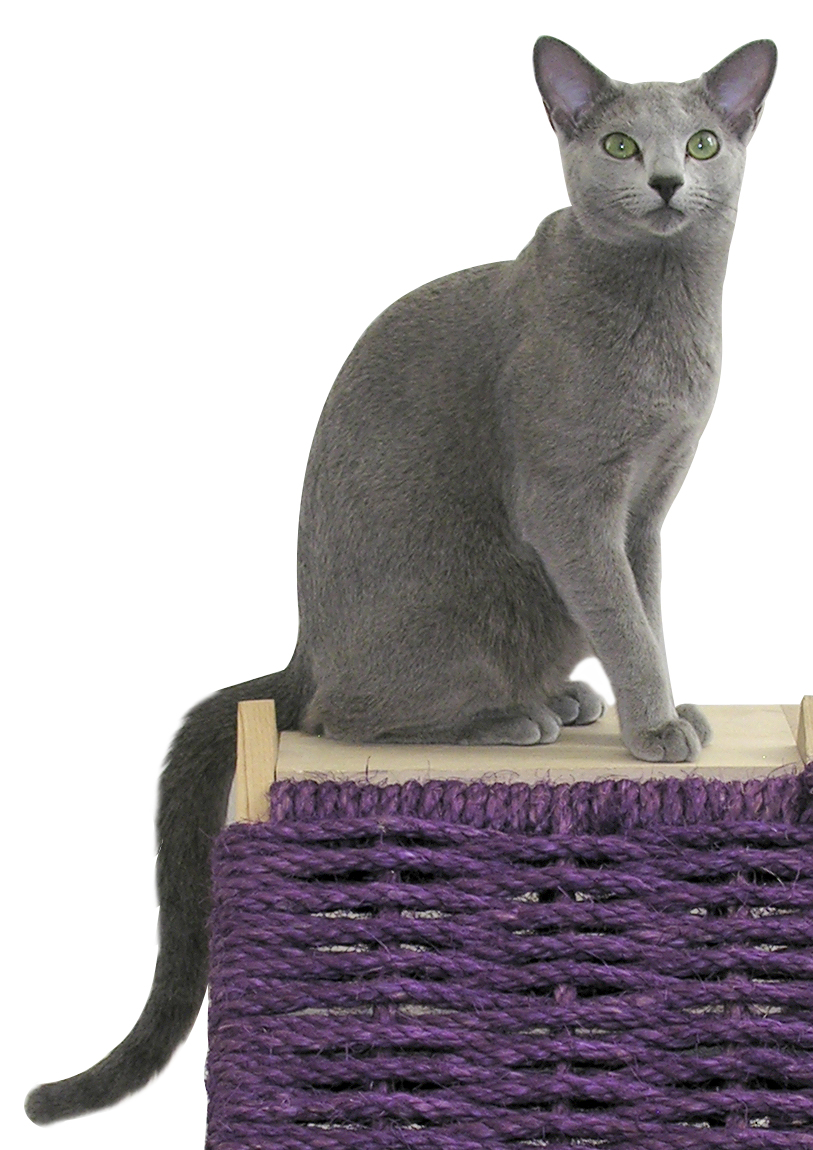- Russian Blue
Infobox Catbreed
name = Russian Blue

imagecaption = 1 year old Russian Blue male
altname = Archangel Blues
nickname =
country =Russia
notrecognized =
extinct =
cfastd = http://www.cfainc.org/breeds/standards/russian.html
fifestd = http://www.fifeweb.org/wp/breeds/std/rus_std.html
ticastd = http://www.tica.org/binary/pdf/publications/standards/rbstd.pdf
gccfstd =
aacestd = http://www.aaceinc.org/pages/breeds/rus.htm
acfastd = http://www.acfacat.com/breeds/standards/russianstd.html
acfstd = http://www.acf.asn.au/Standards/Russian.htm
ccastd = http://www.cca-afc.com/standardsRussian.html
otherstd =
note = The ACF and GCCF also recognize Russian Blues in white and black, however the CFA does not.|The Russian Blue is a type or breed of
cat that has a silver-blue coat. These cats are known to be highly intelligent and playful but tend to be timid around strangers. They also develop close bonds with their human companions and are highly sought after due to their personalities and unique coat.Origin
The Russian Blue is a naturally occurring breed that originated in the port of
Arkhangelsk ,Russia . [>cite web |url=http://www.cfainc.org/breeds/profiles/russian.html |title=Breed Profile: Russian Blue|accessdate=2008-05-06 |format=html] They are also sometimes called Archangel Blues. [ cite book
last = Alderton
first = David
title =The Eyewitness Handbook of Cats
publisher =Dorling Kindersley
date= 1992
pages = p. 182
isbn = 1-56458-070-9 ] It is believed that the first Russian Blues were first brought from the Archangel Isles to England and Northern Europe in the 1860s by sailors. The first recorded showing of the breed was in 1875 at the Crystal Palace in England as the Archangel Cat. The Russian Blue competed in a class including all other blue cats, until 1912, when it was given its own class.The breed was developed mainly in
England andScandinavia until afterWorld War II . During and followingWorld War II , due to a lack of numbers of Russian Blues, some people started cross breeding it with the Siamese. Although the breed was in America before the war, it was not until after World War II that American Breeders created what is known as the modern Russian Blue that is seen in the US today. This was done by combining the bloodlines of both the Scandinavian and English Russian Blues. The Siamese traits have now been largely bred out.Although they have been used on a limited basis to create other breeds (such as the
Havana Brown ) or add type to a breed in creation (theNebelung ), Russian Blues themselves are short-haired, blue-grey cats.During the early 1970s, a solid white Russian Blue (called the
Russian White ) was created by the Australian breeder,Mavis Jones , through the crossing of a Russian Blue with a domestic white cat. [cite web |url=http://www.geocities.com/Petsburgh/Farm/3884/NARWA2.html |title=History of the Russian White |accessdate=2007-11-29 |format=html |publisher=North American Russian White Association] By the late 1970s, the Russian White and Russian Black colors were accepted by cat fanciers in Australia as Russian cats (in different classes). However, in North America, theCat Fanciers Association , does not recognize either variations of the Russian Blue; onlyThe International Cat Association recognize the Russian Whites and Russian Blacks but in the provisional classes.Physical characteristics
The Russian Blue has a lean elongated body and a short, plush, blue-grey coat. The color is a bluish-grey that is the dilute expression of the black gene. The coat is known as a "double coat," with the undercoat being soft, downy, and equal in length to the
guard hair s, which are an even blue with silver tips. Only Russian Blues and the FrenchChartreux have this type of coat, which is described as thick and wonderfully soft to the touch. The silver tips give the coat a shimmering appearance. Its eyes are almost always a dark and vivid green. Any white patches or yellow eyes in adulthood are seen as faults in show cats.Russian Blues should not be confused with British Blues (which are not a distinct breed but rather a
British Shorthair with a blue coat), nor theChartreux orKorat which are two other naturally occurring breeds of blue cats, although they have similar traits.Behavioral characteristics
The Russian Blue is known for being a very intelligent and active animal. They have been known to open doors/windows, play fetch, and are sensitive to basic human emotions. They enjoy playing with a variety of toys and develop extremely loyal bonds to their loved ones. The Russian Blue is also known for getting along very well with other pets and children in a household. They are known also for being quiet and clean animals that are normally shy around strangers, unless they are brought up in a very active household. The males are known to be more active and outgoing than the females according to many breeders.
Hypoallergenic
Some
anecdotal evidence stated by breeders have said that the Russian Blue breed ishypoallergenic . [cite web |url=http://www.xcalibur-bouviers.com/ |title= Breeder statement: Russian Blues are hypoallergenic |accessdate=2007-11-30 |format=html] [cite web |url= http://www.diynetwork.com/diy/lp_cats/article/0,2041,DIY_14060_2272979,00.html |title= They don't shed, ... makes them a good choice for people who may have allergies to other breeds. |accessdate=2007-01-17 |format=html] Yet others point out that no cat is truly free of allergens. [cite web |url= http://www.cat-world.com.au/Hypoallergenic.htm |title= No cat is truly hypoallergenic. |accessdate=2007-11-30 |format=html]References and Sources
ee also
Russian White, Black and Tabby External links
* [http://www.cfainc.org/breeds/profiles/russian.html Breed profile] and [http://www.cfainc.org/breeds/profiles/articles/russian-blue.html Breed article] at
Cat Fanciers' Association [http://www.russianbluebc.org CFA Russian Blue Breed Council]
[http://www.russianblue.info Russian Blue Information]
Wikimedia Foundation. 2010.
